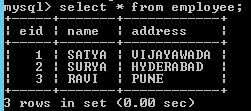Hibernate Cache
In Hibernate, Every fresh session having its own cache memory, Caching is a mechanism for storing the loaded objects into a cache memory.
The advantage of cache mechanism is, whenever again we want to load the same object from the database then instead of hitting the database once again, it loads from the local cache memory only, so that the no. of round trips between an application and a database server got decreased.
It means caching mechanism increases the performance of the application.
In hibernate we have two levels of caching
-
First Level Cache (Session Cache)
-
Second Level Cache (Session Factory Cache/ JVM Level Cache)
1.First Level Cache
-
By default, for each hibernate application, the first level cache is automatically enabled. We can’t Enable/Disable first level cache
-
the first level cache is associated with the session object and scope of the cache is limited to one session only
-
When we load an object for the first time from the database then the object will be loaded from the database and the loaded object will be stored in the cache memory maintained by that session object
-
If we load the same object once again, with in the same session, then the object will be loaded from the local cache memory not from the database
-
If we load the same object by opening other session, then again the object will load from the database and the loaded object will be stored in the cache memory maintained by this new session
Example:
Session session = factory.openSession();
Object ob1 = session.get(Actor.class, new Integer(101)); //1
Object ob2 = session.get(Actor.class, new Integer(101));//2
Object ob3 = session.get(Actor.class, new Integer(101));//3
session.close();//4
Session ses2 = factory.openSession();
Object ob5 = ses2.get(Actor.class, new Integer(101));//5
1, We are loaded object with id 101, now it will load the object from the
database only as its the first time, and keeps this object in the session cache
2,3 i tried to load the same object 2 times, but here the object will be loaded
from the stored cache only not from the database, as we are in the same session
4, we close the first session, so the cache memory related this session also
will be destroyed
5, again i created one new session and loaded the same object with id 101, but
this time hibernate will loads the object from the database
if we want to remove the objects that are stored in the cache memory, then we
need to call either evict() or clear() methods
2.Second Level Cache
Whenever we are loading any object from the database, then hibernate verify whether that object is available in the local cache(first level cache) memory of that particular session, if not available then hibernate verify whether the object is available in global cache(second level cache), if not available then hibernate will hit the database and loads the object from there, and then first stores in the local cache of the session , then in the global cache
SessionFactory holds the second level cache data. It is global for all the session objects and not enabled by default.
Different vendors have provided the implementation of Second Level Cache
-
EH Cache
-
OS Cache
-
Swarm Cache
-
JBoss Cache
To enable second level cache in the hibernate, then the following 3 changes are required
1.Add provider class in hibernate configuration file
<property name="hibernate.cache.provider_class">
org.hibernate.cache.EhCacheProvider
</property>
2.Configure cache element for a class in hibernate mapping file
<cache usage="read-only" />
-
read-only: caching will work for read only operation.
-
nonstrict-read-write: caching will work for read and write but one at a time.
-
read-write: caching will work for read and write, can be used simultaneously.
-
transactional: caching will work for transaction.
3.create xml file called ehcache.xml and place where you have mapping and configuration xml’s
Example:
public class Employee {
private int eid;
private String name;
private String address;
//Setters & Getteers
}
Employee.hbm.xml
<hibernate-mapping package="cache">
<class name="Employee" table="employee">
<cache usage="read-only" />
<id name="eid" column="eid">
<generator class="native"></generator>
</id>
<property name="name"></property>
<property name="address"></property>
</class>
</hibernate-mapping>
ehcache.xml
<?xml version="1.0"?>
<ehcache>
<defaultCache maxElementsInMemory="100"
eternal="false" timeToIdleSeconds="120" timeToLiveSeconds="200" />
<cache name="cache.Employee" maxElementsInMemory="100"
eternal="false" timeToIdleSeconds="5" timeToLiveSeconds="200" />
</ehcache>
hibernate.cfg.xml
<hibernate-configuration>
<session-factory>
<property> Driver Class, URL, Username, password, etc </property>
<property name="cache.provider_class">org.hibernate.cache.EhCacheProvider</property>
<property name="hibernate.cache.use_second_level_cache">true</property>
<mapping resource="cache/employee.hbm.xml" />
</session-factory>
</hibernate-configuration>
CacheDemo.java
package cache;
import org.hibernate.*;
import org.hibernate.cfg.*;
public class CacheDemo {
public static void main(String[] args) {
//1.Load Configuration
Configuration cfg = new Configuration();
cfg.configure("hibernate.cfg.xml");
//2.Create Session
SessionFactory sf = cfg.buildSessionFactory();
Session session = sf.openSession();
//3.Perform Operations
Object ob = session.load(Employee.class, new Integer(1));
Employee bo = (Employee) ob;
System.out.println("SELECTED DATA\n ================");
System.out.println("SNO : "+bo.getEid());
System.out.println("NAME : "+bo.getName());
System.out.println("ADDRESS : "+bo.getAddress());
}
}
